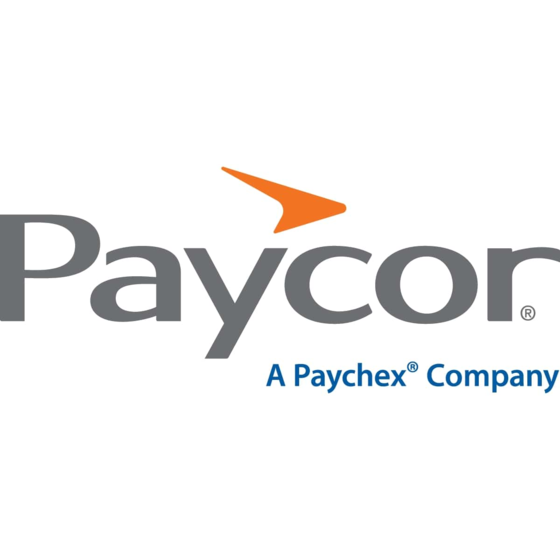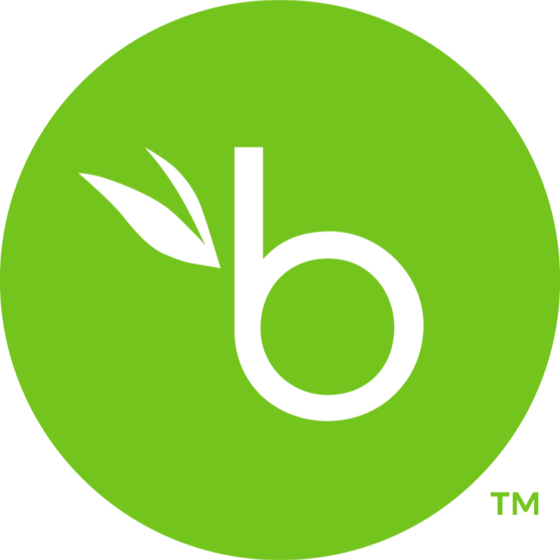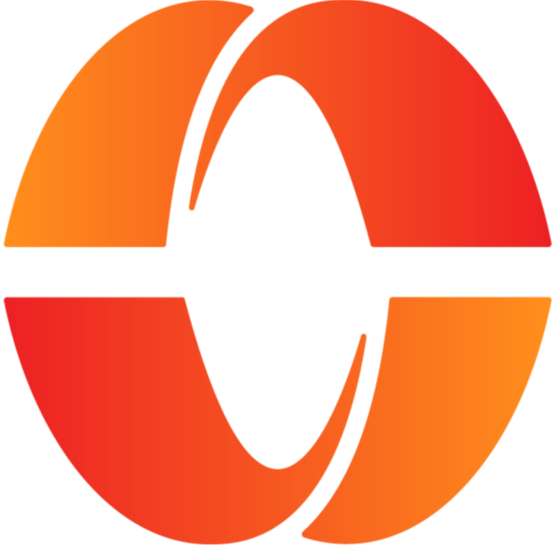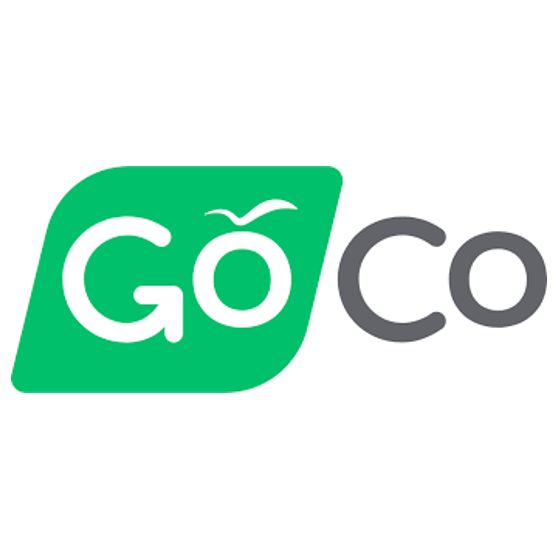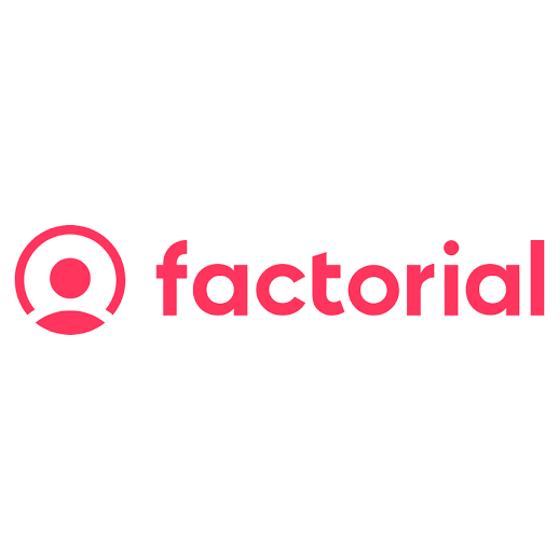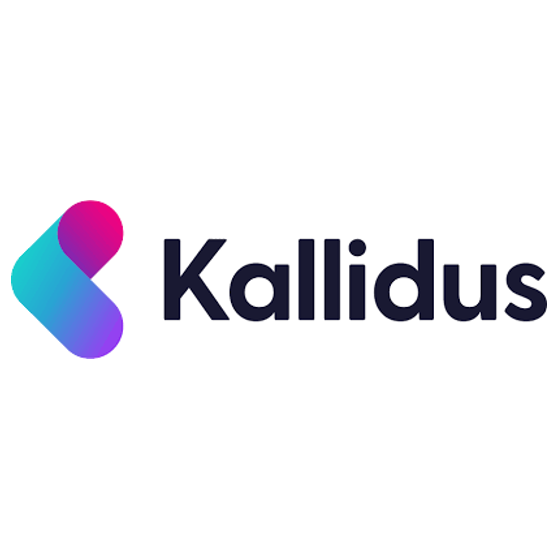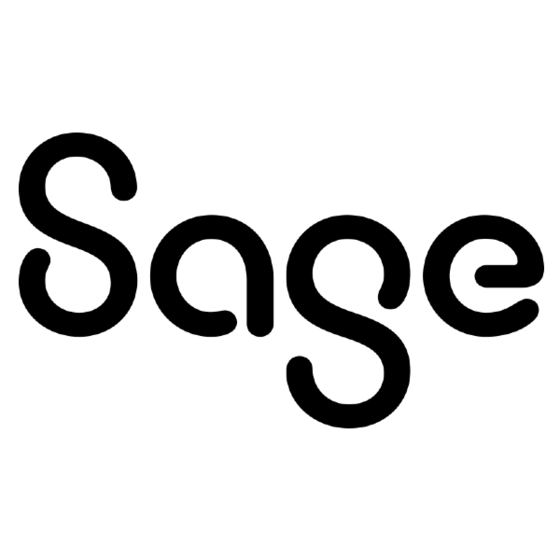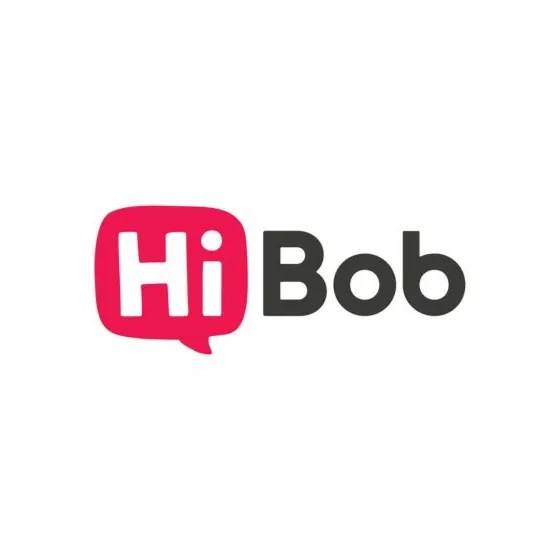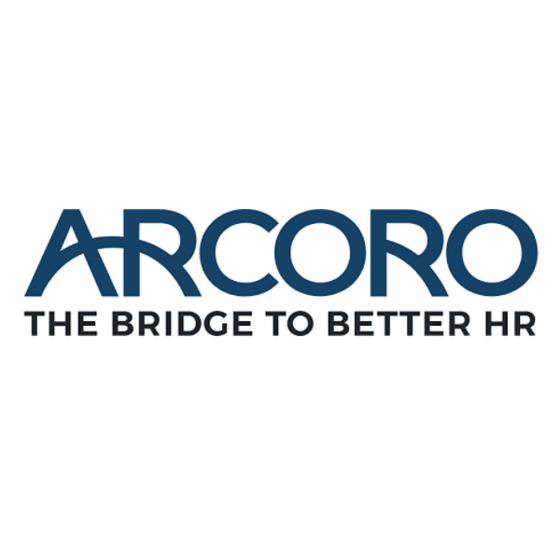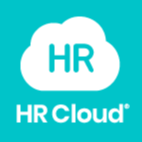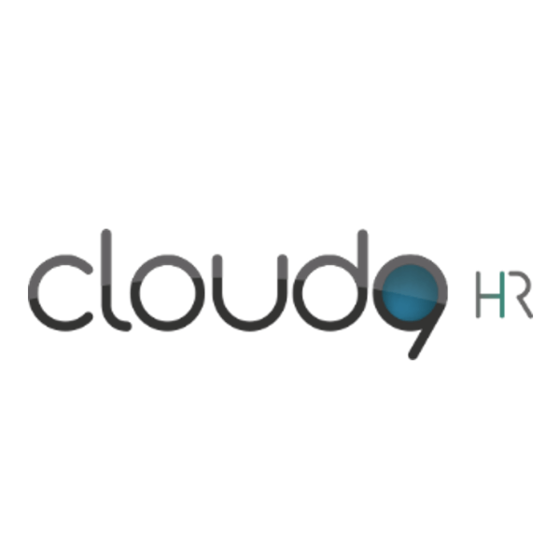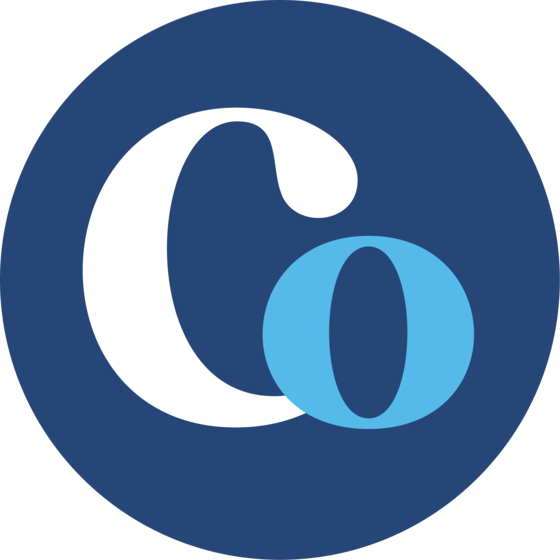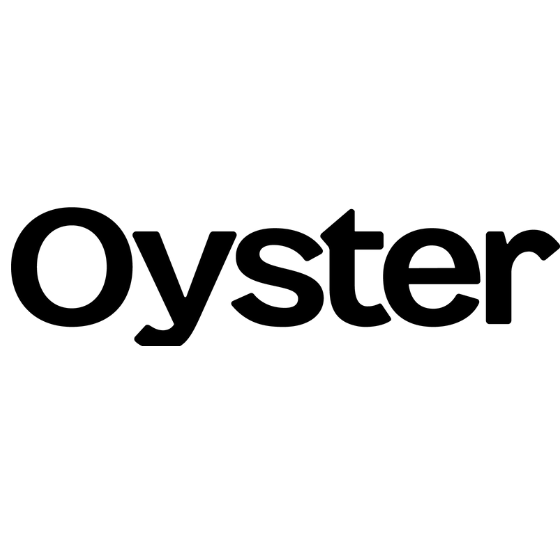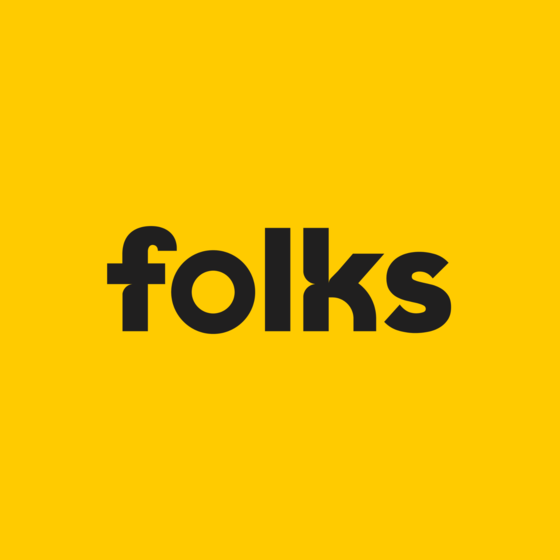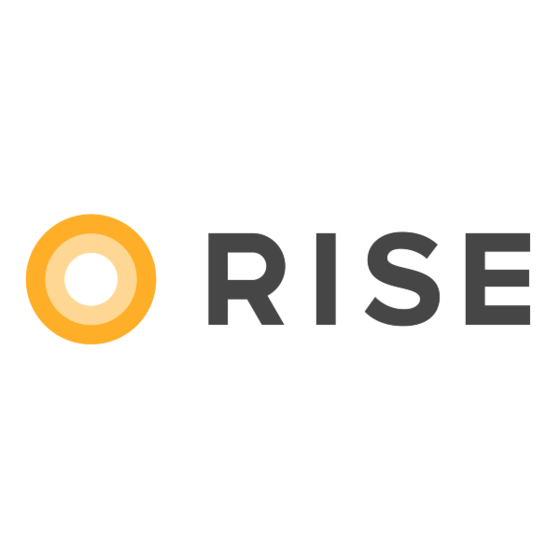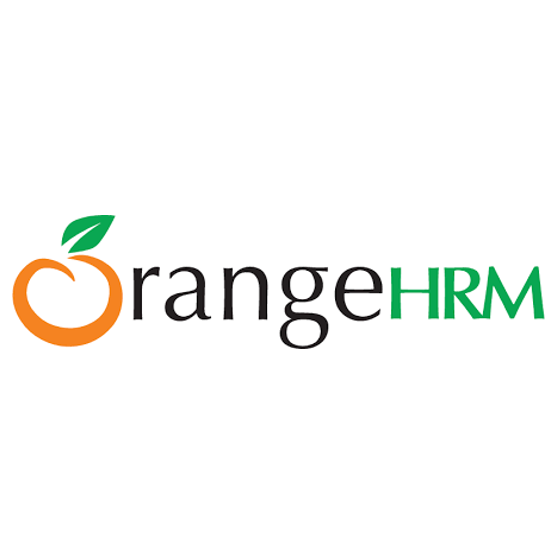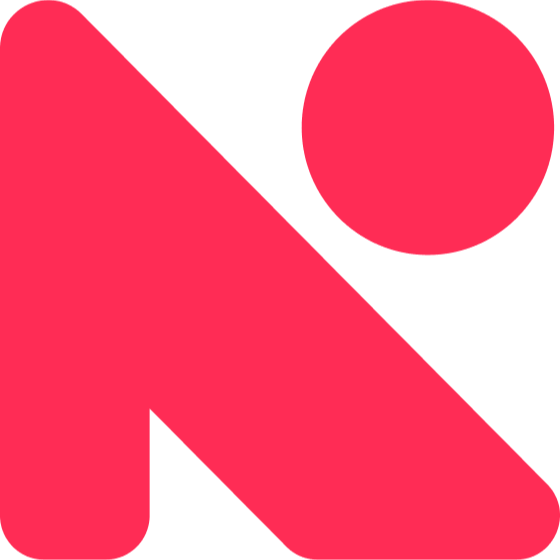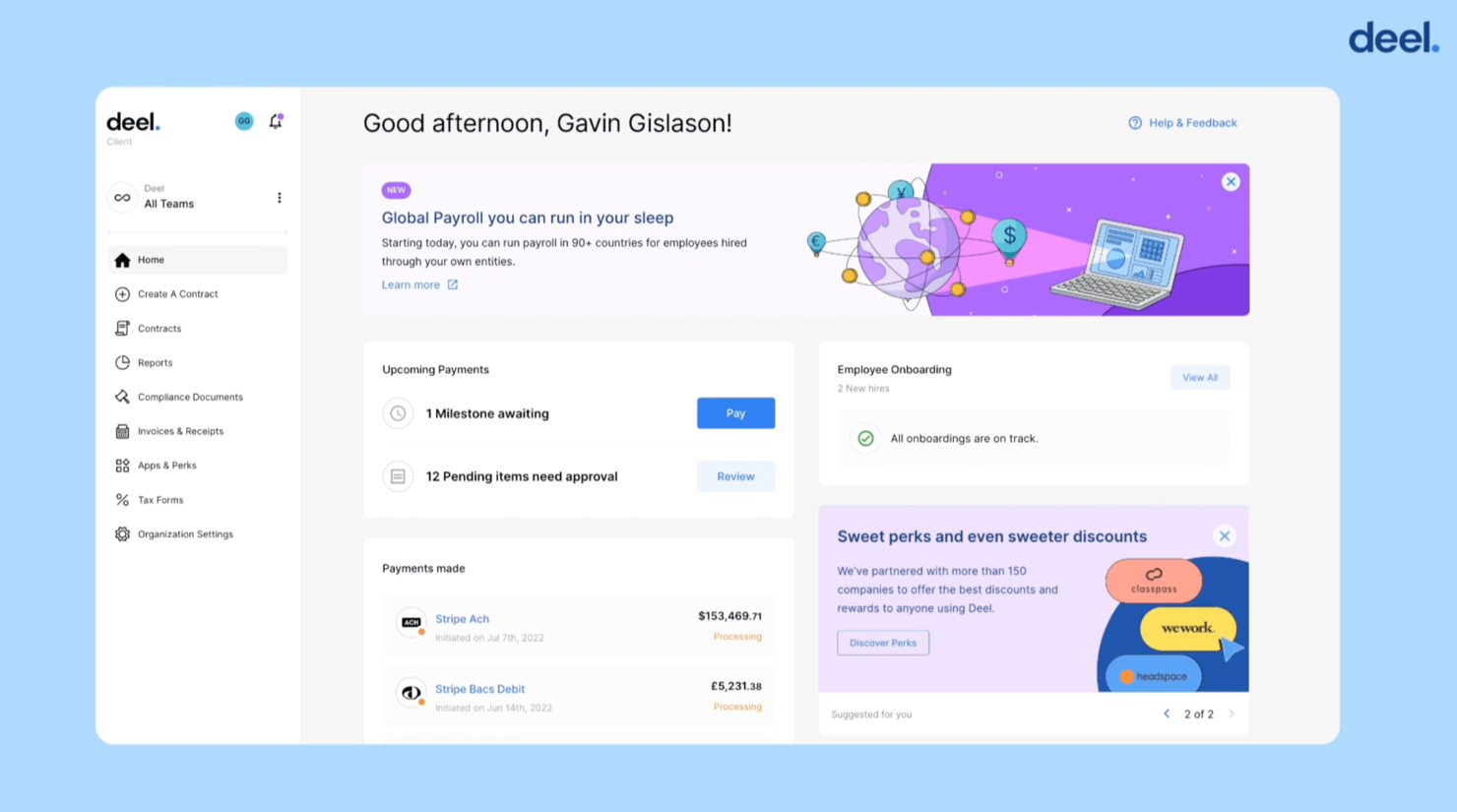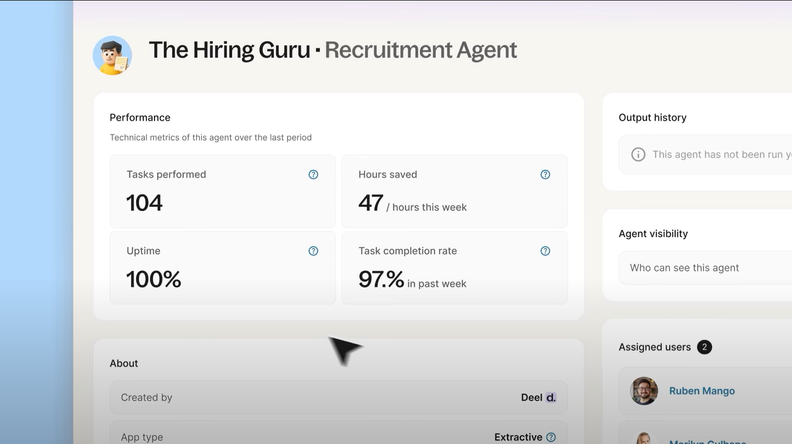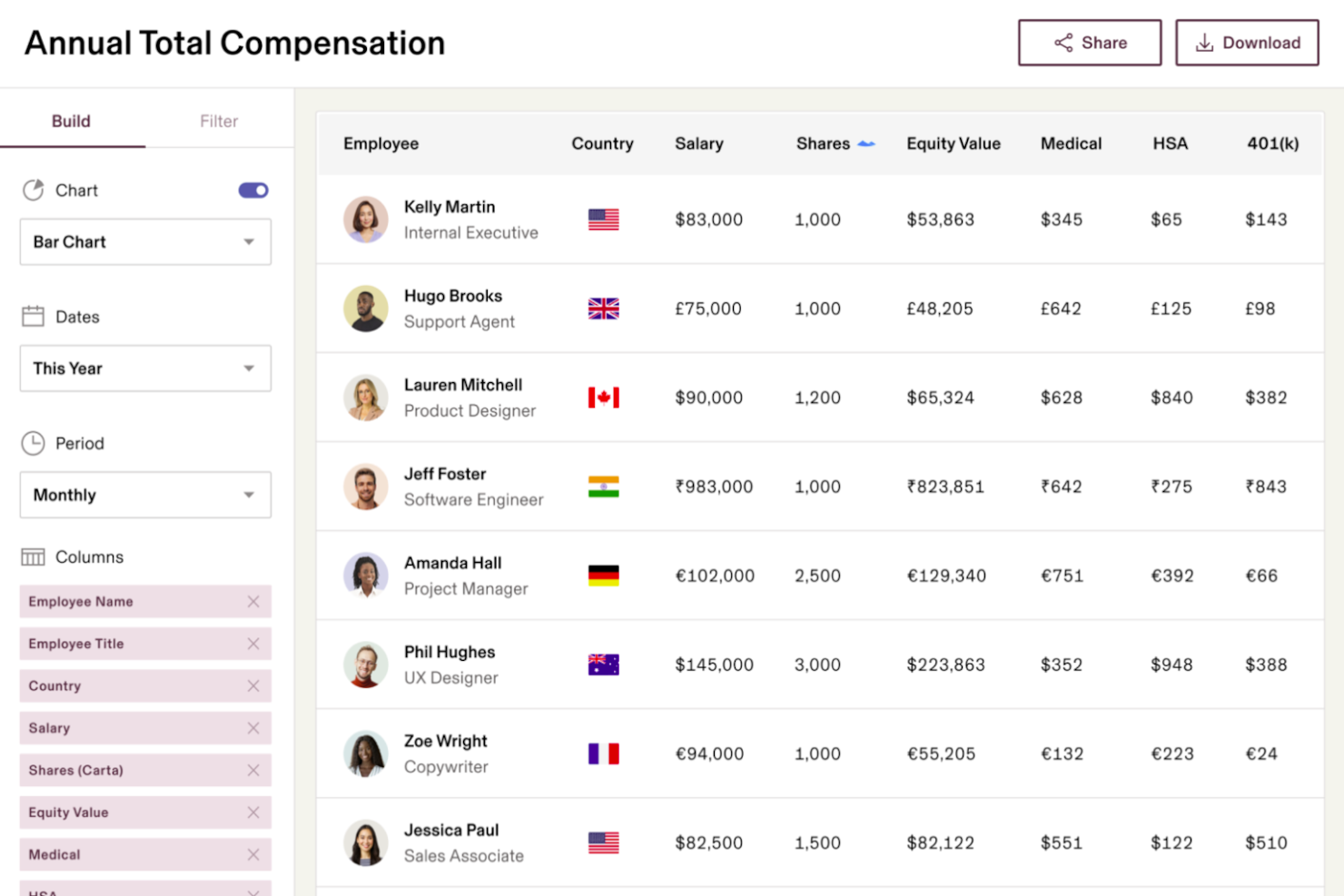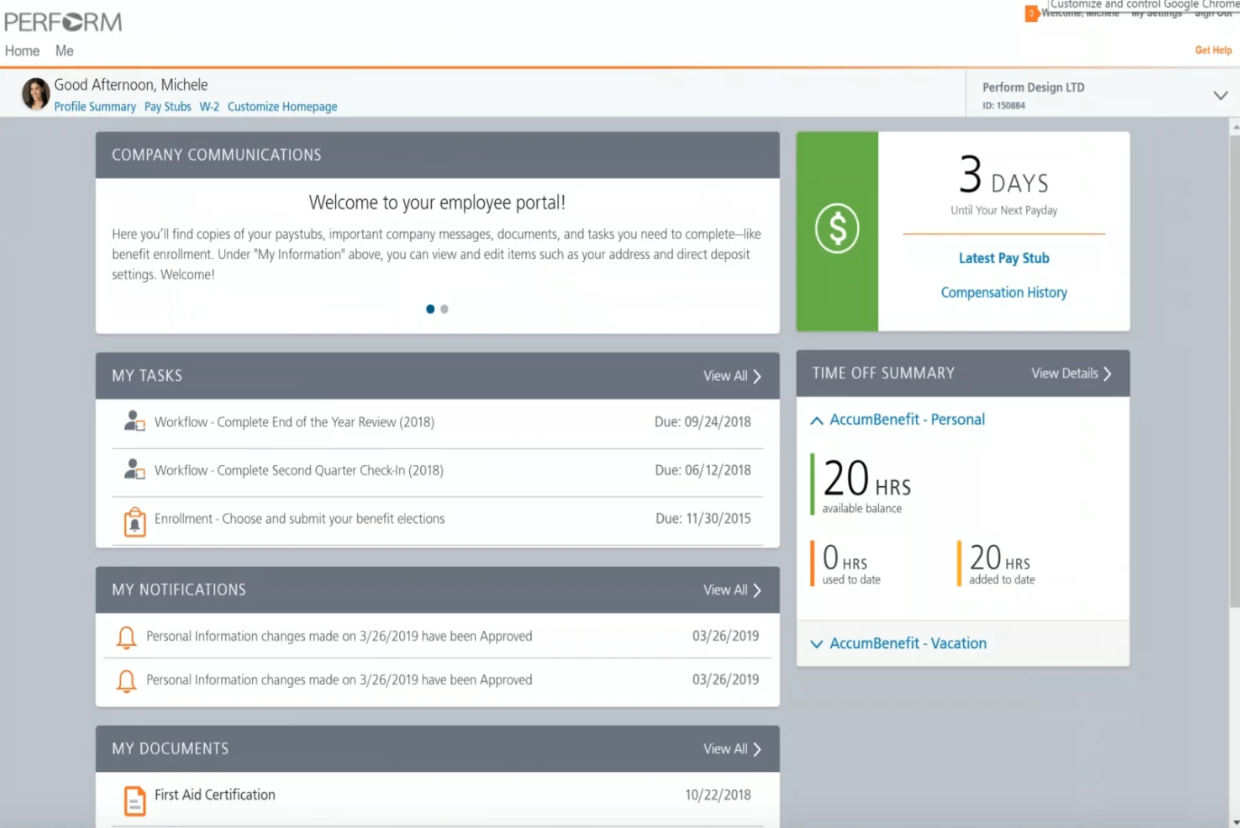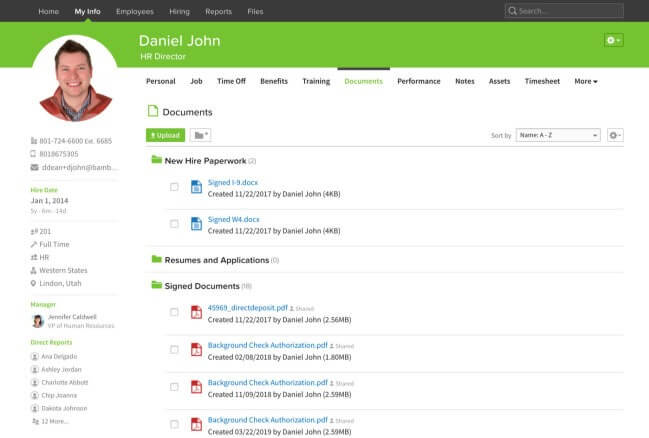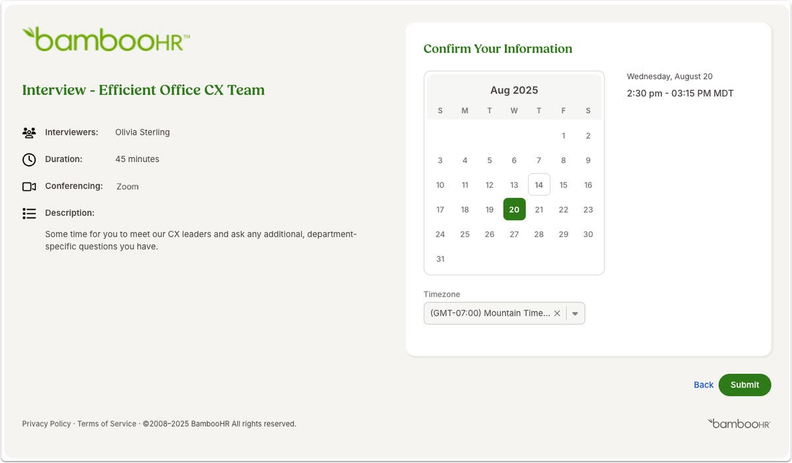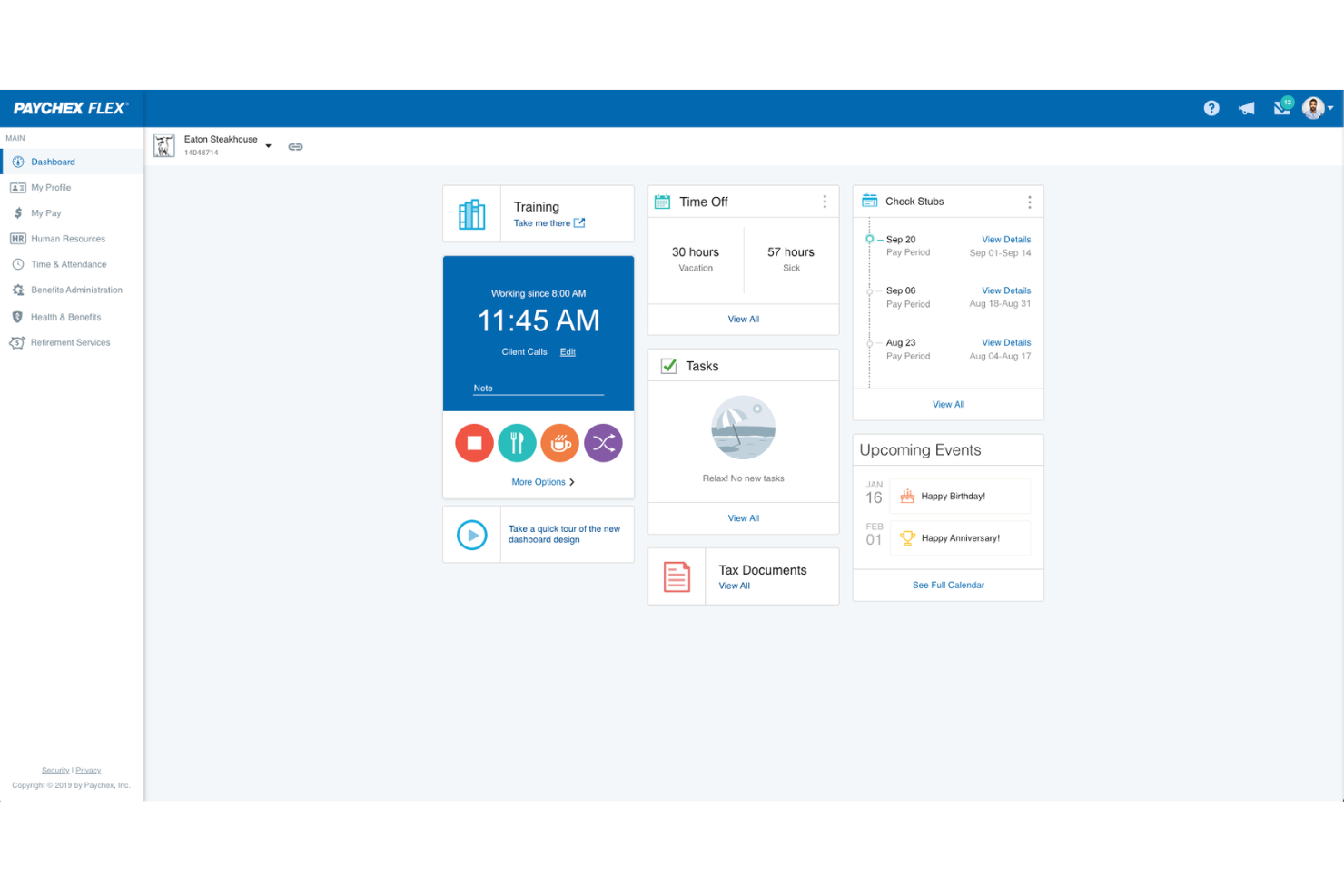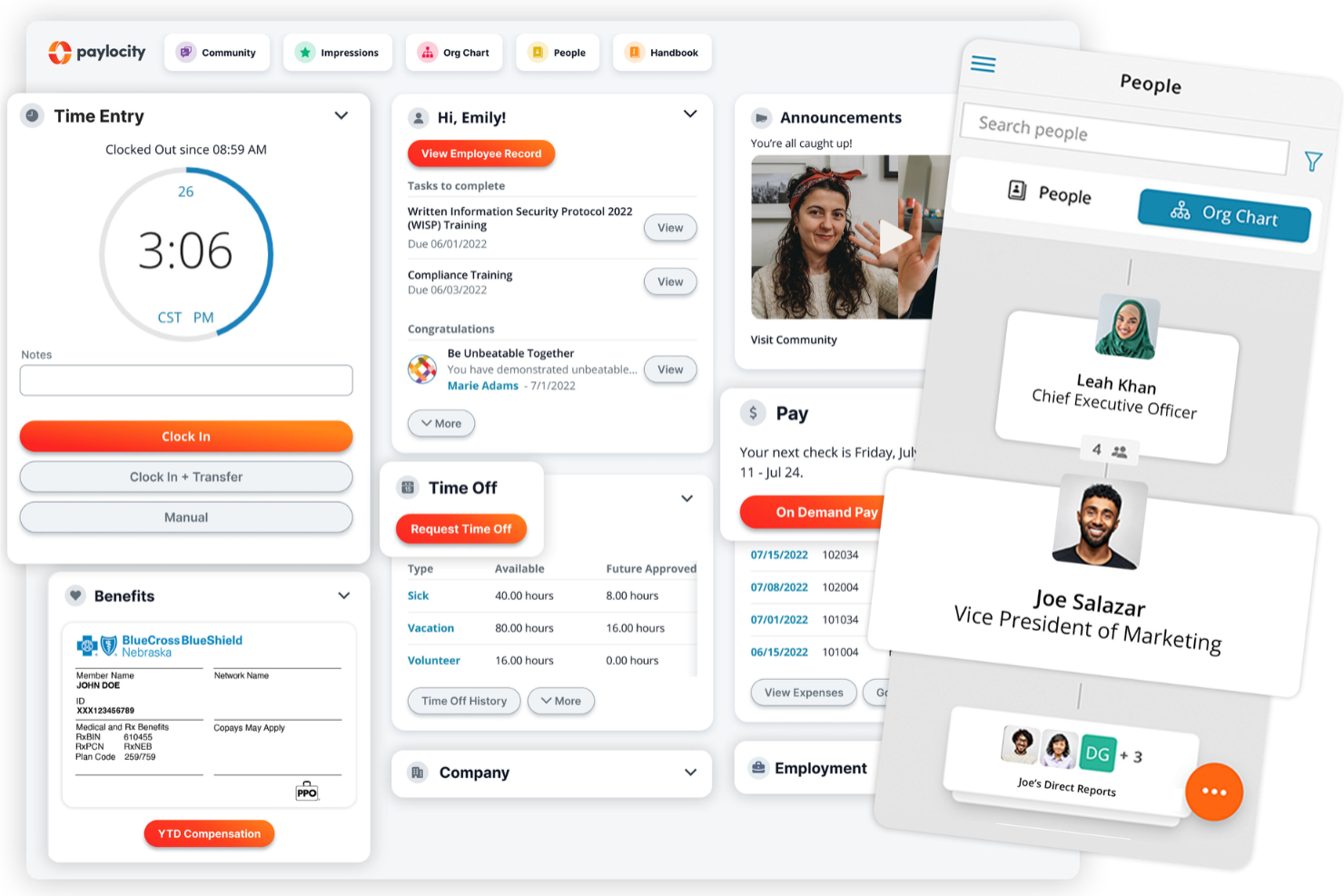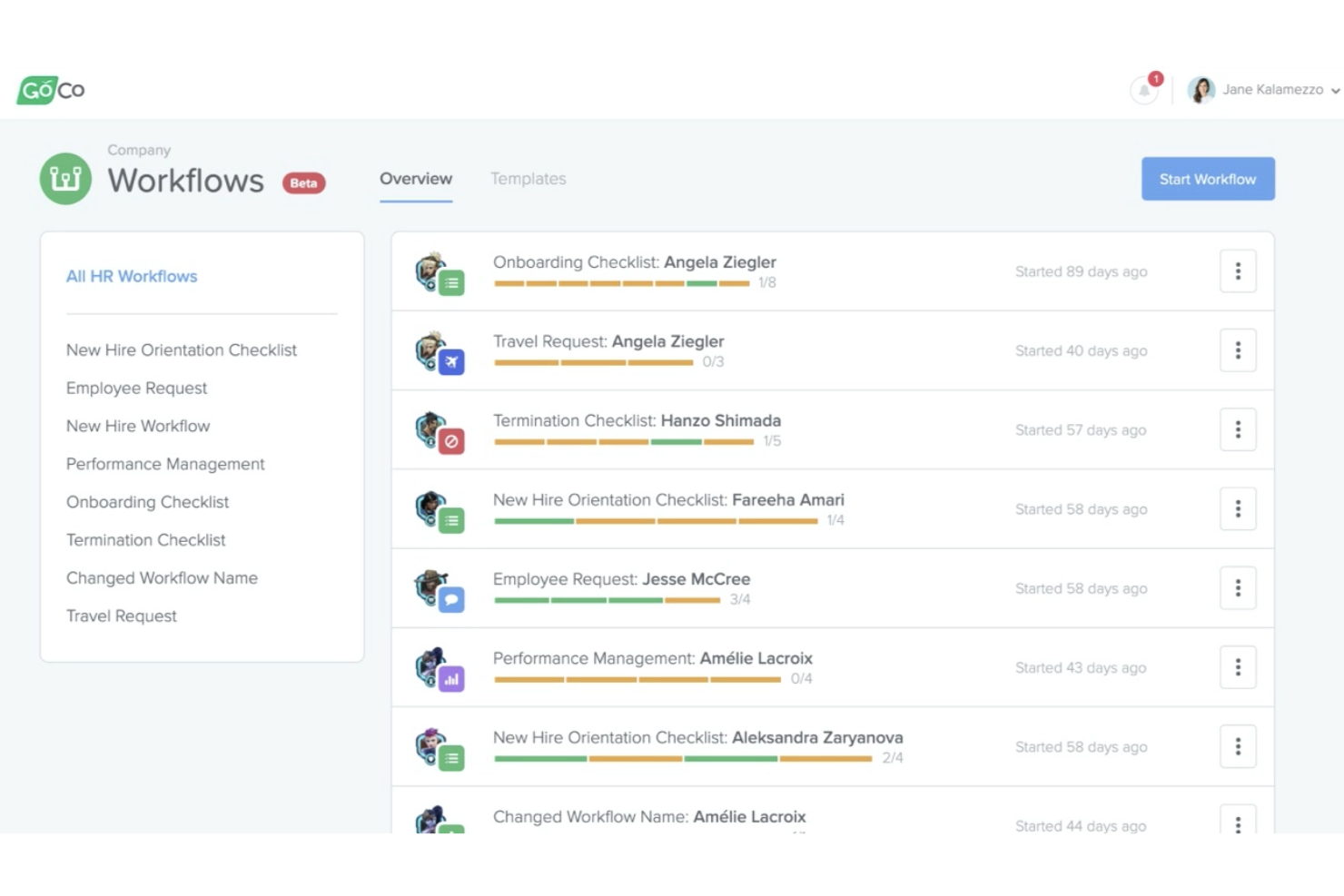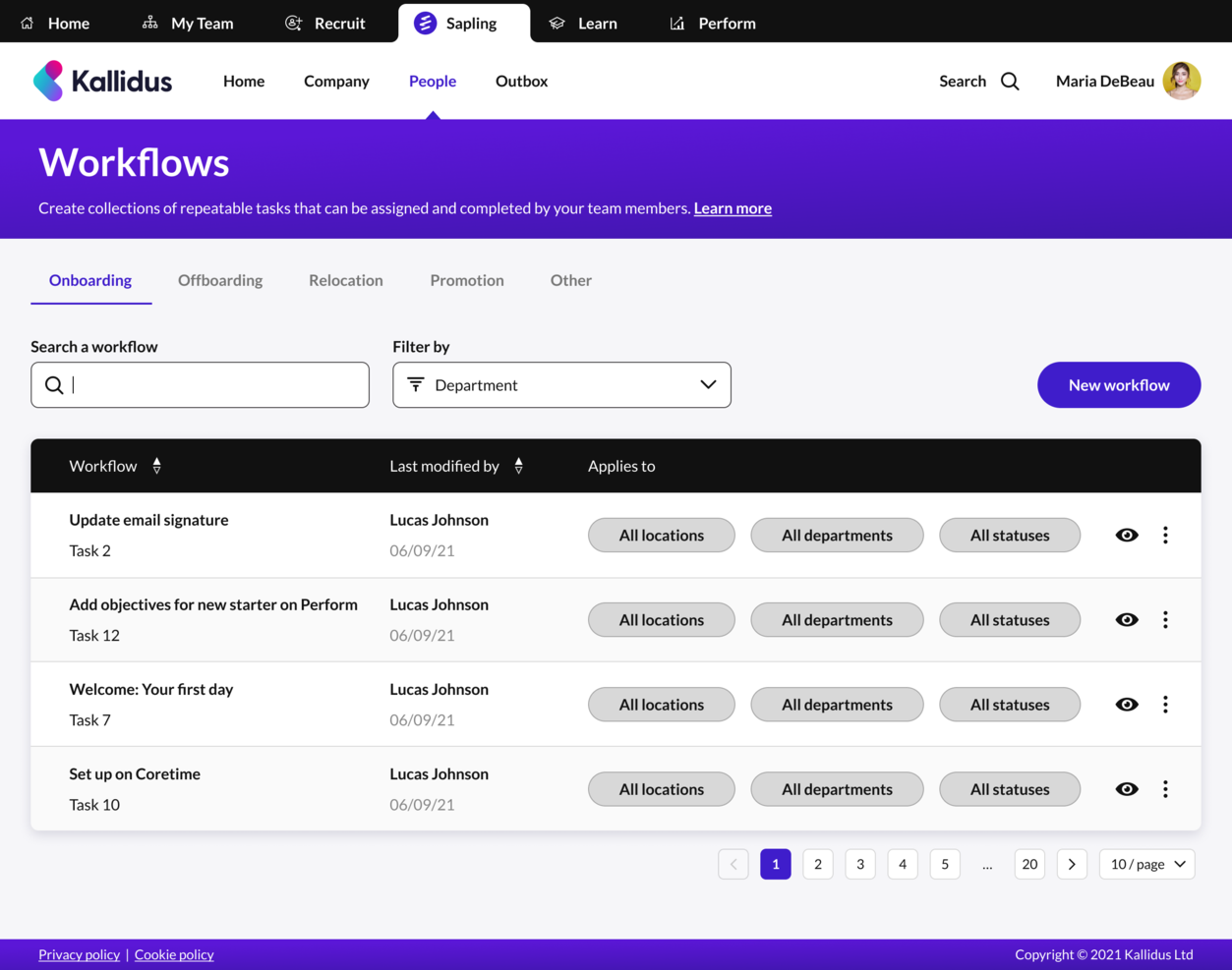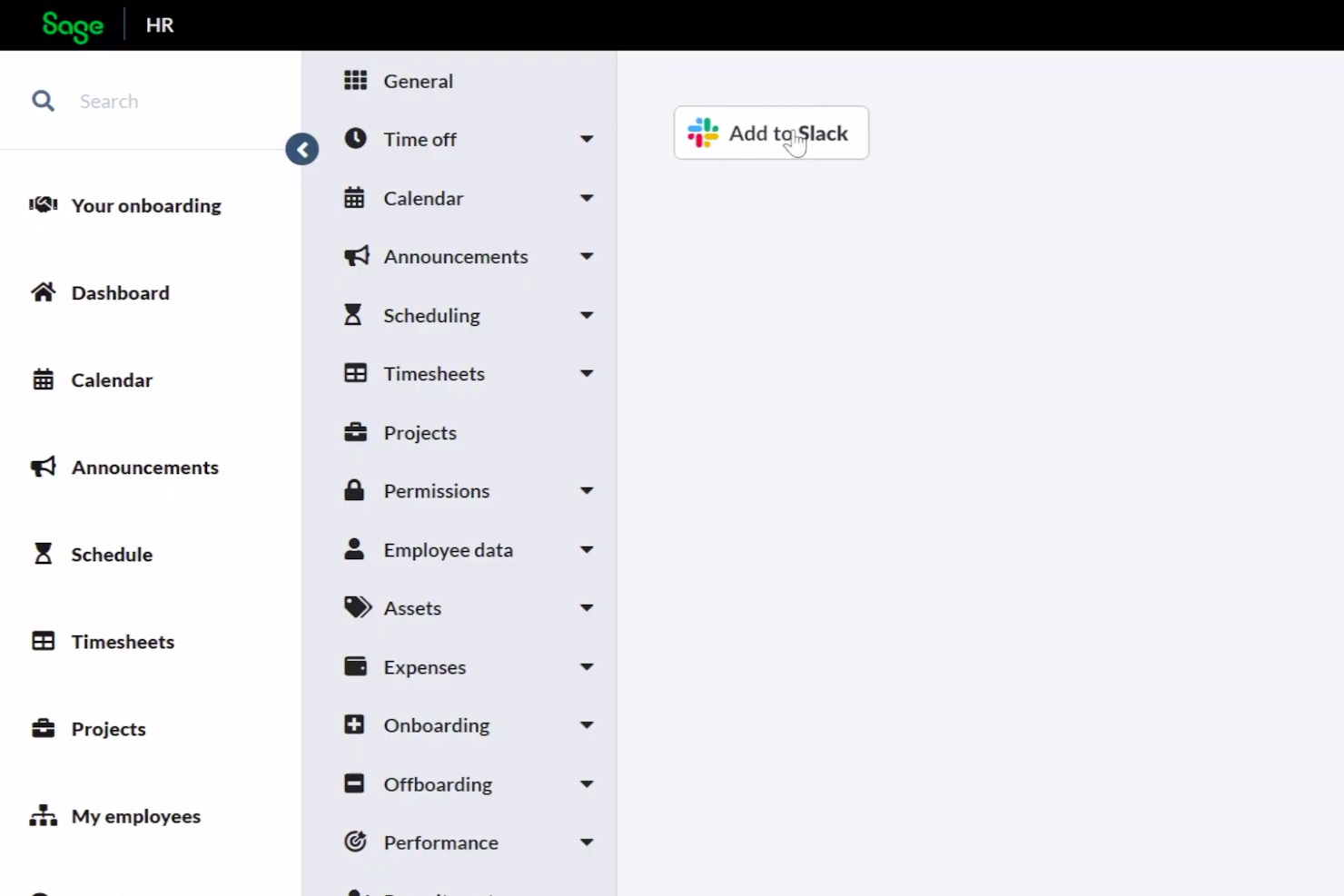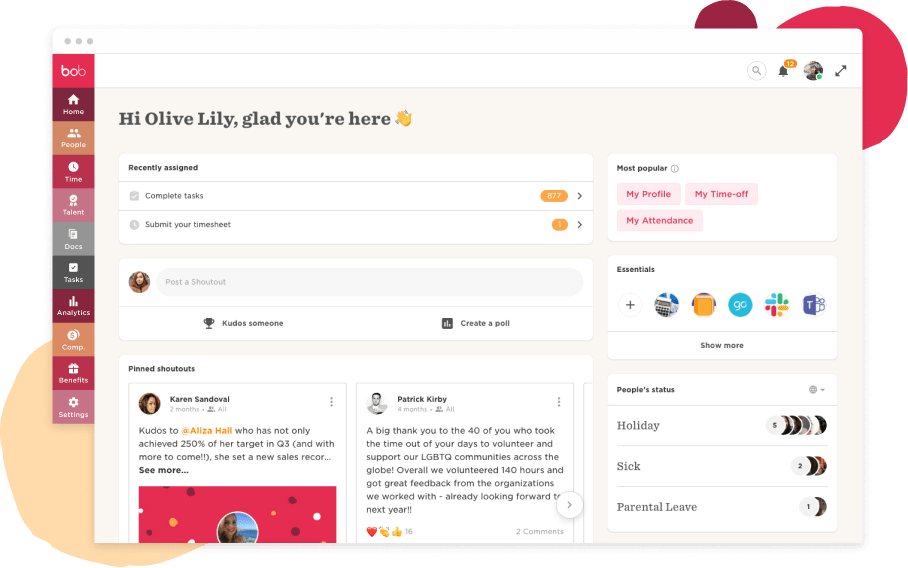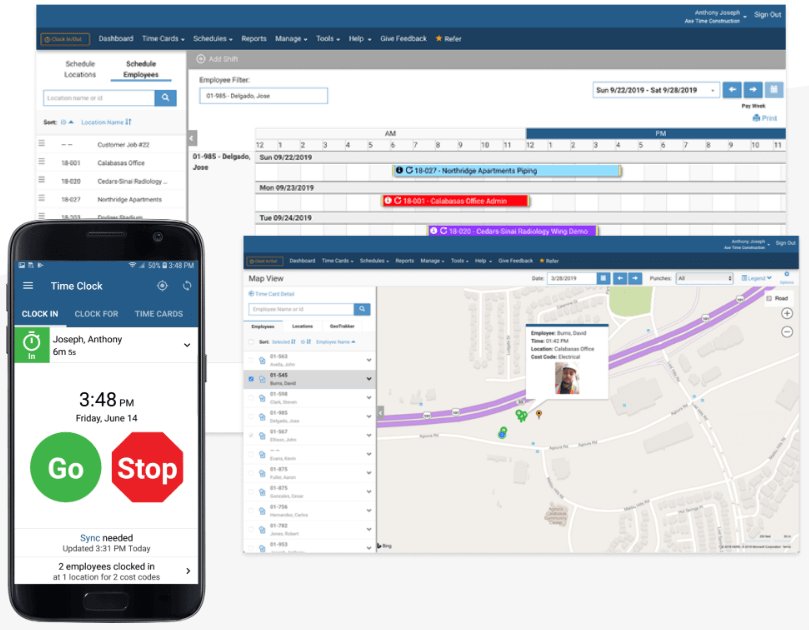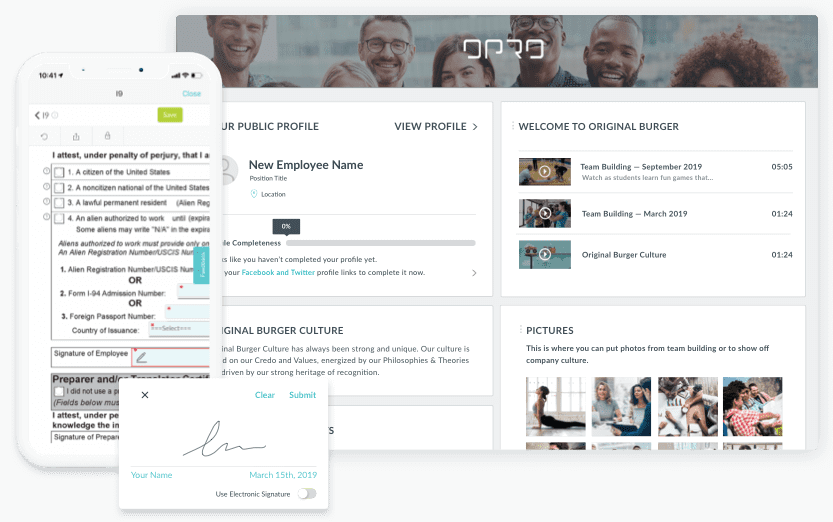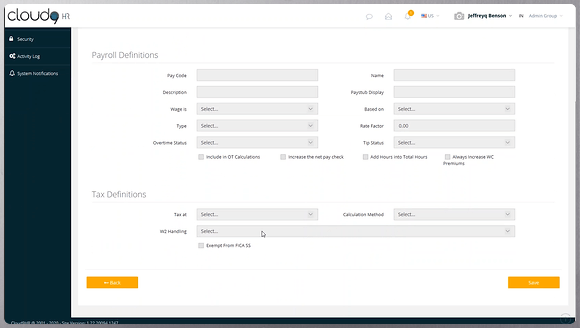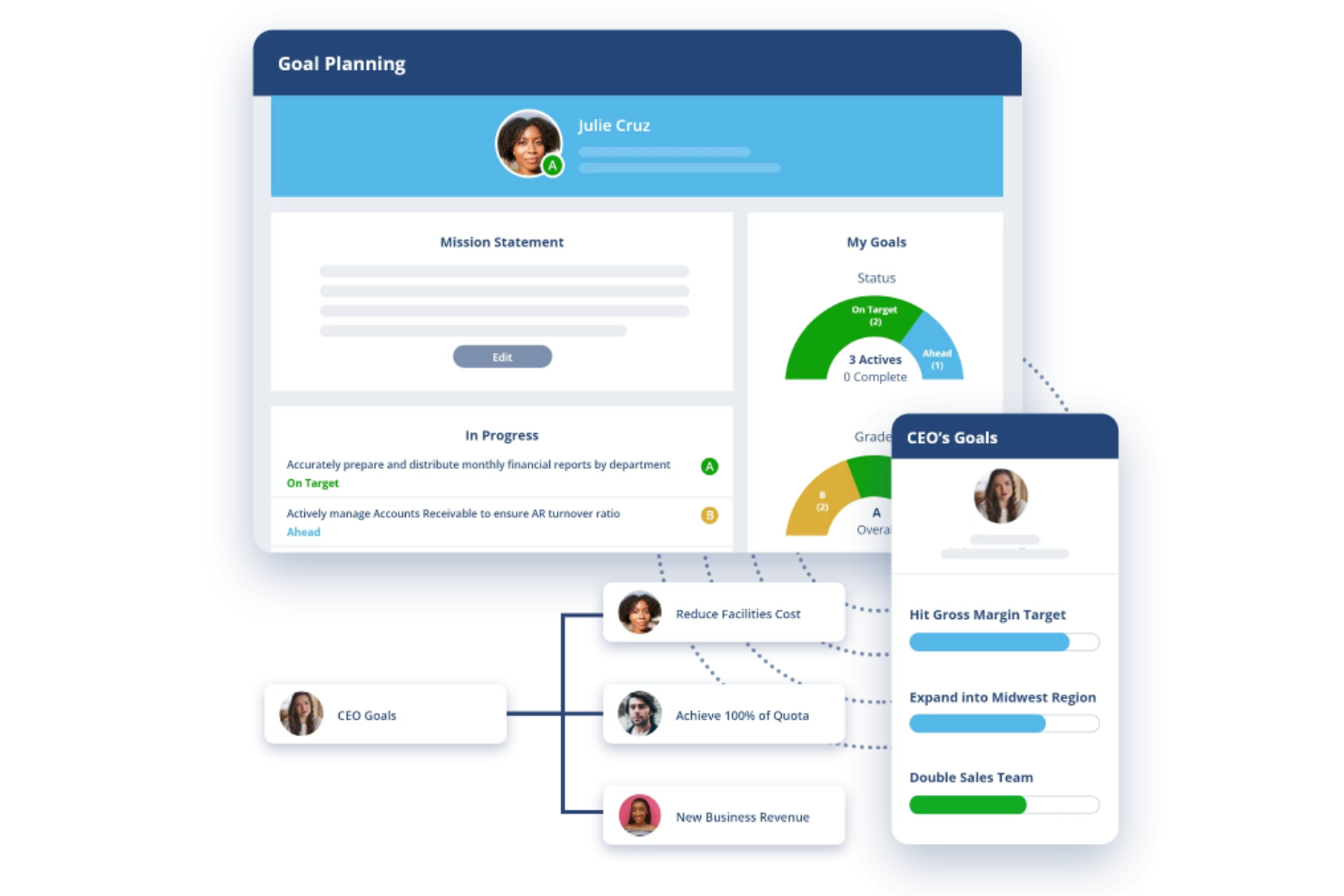20 Best Cloud HR Software Shortlist
Here's my pick of the 20 best software from the 28 tools reviewed.
The best cloud-based HR software helps you manage payroll, recruitment, performance, and compliance from anywhere—keeping your data secure, centralized, and always up to date.
When HR processes rely on spreadsheets or outdated on-premise systems, it slows teams down and makes collaboration difficult. Cloud HR platforms eliminate those barriers by automating workflows, improving accessibility, and ensuring your data is backed up and protected.
After testing dozens of HR tools firsthand, I’ve shortlisted the top cloud HR software that’s intuitive, scalable, and built to fit modern, flexible workplaces. In this guide, you’ll find solutions that streamline operations, save time, and make managing your people easier—wherever work happens.
Why Trust Our HR Software Reviews
We've been testing and reviewing HR software since 2019. As HR professionals ourselves, we know how critical and difficult it is to make the right decision when selecting software.
We invest in deep research to help our audience make better software purchasing decisions. We've tested more than 2,000 tools for different HR use cases and written over 1,000 comprehensive software reviews. Learn how we stay transparent, and take a look at our software review methodology.
Best Cloud HR Software Systems: Pricing Comparison Chart
This comparison chart summarizes pricing details for my top cloud HR software selections to help you find the best HR software for your budget and business needs.
| Tool | Best For | Trial Info | Price | ||
|---|---|---|---|---|---|
| 1 | Best for end-to-end global payroll management | Free trial + demo available | From $29/month | Website | |
| 2 | Best for automated onboarding | Free demo available | From $8/user/month (billed annually) | Website | |
| 3 | Best for employee self-service | 30-day free trial | Pricing upon request | Website | |
| 4 | Best for core HR features | 7-day free trial | From $6.19/user/month (billed annually) | Website | |
| 5 | Best for complex HR processes | Free demo available | Pricing upon request | Website | |
| 6 | Best for AI-driven HR automation | Free demo available | Pricing upon request | Website | |
| 7 | Best with integrated benefits administration | Free demo available | Pricing upon request | Website | |
| 8 | Best or employee well-being | 14-day free trial | From $4.50/user/month | Website | |
| 9 | Best for customizing workflows | Free demo available | Pricing upon request | Website | |
| 10 | Best for managing talent and succession planning | 30-day free trial | From $6/employee/month | Website | |
| 11 | Best for connecting hybrid teams | Free demo available | Pricing upon request | Website | |
| 12 | Best for health and safety-focused industries | Free demo available | Pricing upon request | Website | |
| 13 | Best for digital onboarding and offboarding | Free demo available | Pricing upon request | Website | |
| 14 | Best for Canadian SMBs | Free demo available | From $8/user/month | Website | |
| 15 | Best for organizational management | Free demo available | Pricing upon request | Website | |
| 16 | Best for the full employee lifecycle | Free demo available | Pricing upon request | Website | |
| 17 | Best for international hiring | 30-day free trial | From $25/employee/month | Website | |
| 18 | Best cloud HRIS system for Canadian non-profit organizations | Free demo available | Pricing upon request | Website | |
| 19 | Best for Canadian companies with lean HR teams | 90-day free trial + free demo | From $8/user/month (billed annually) | Website | |
| 20 | Best free cloud-based HRMS software, available via open source | 30-day free trial + free plan available | From $6/user/month | Website |
-

Native Teams
Visit WebsiteThis is an aggregated rating for this tool including ratings from Crozdesk users and ratings from other sites.4.9 -

Rippling
Visit WebsiteThis is an aggregated rating for this tool including ratings from Crozdesk users and ratings from other sites.4.8 -

Paylocity
Visit WebsiteThis is an aggregated rating for this tool including ratings from Crozdesk users and ratings from other sites.4.5
Best Cloud HR Software Reviews
Here are my detailed summaries of the best cloud HR software that made it into my top 10 list, including notes on why I picked them. Each review offers a detailed look at the key features, integrations, and ideal use cases of each system to help you find the best tool for you.
Deel is an excellent cloud-based HRIS for businesses that need to manage employee data and handle payroll tax compliance. It’s used by companies like Dropbox and Shopify to handle their global workforces.
Why I picked Deel: Deel's platform can hire employees or contractors in over 150 countries on your behalf as an employer of record, eliminating the need to set up a new entity or understand foreign payroll requirements. The platform is easy to use and provides a variety of features that make it a great choice for businesses of all sizes. You can also use Deel to offer international benefits, offer stock options, and track equipment in a streamlined manner.
Deel Standout Features and Integrations:
Features include contract management, expense reimbursements, and off-cycle adjustments. Employees can also self-manage their pay and personal data independently, which reduces admin load.
The platform does not provide tools for screening candidates or tracking applications but integrates with applicant tracking systems like Ashby and Greenhouse. You can also import qualified candidate data directly into Deel to initiate onboarding and use Deel’s built-in Veriff integration to validate users.
The company provides 24/7 client support and live chat. Any company considering hiring an international worker should evaluate Deel for their workforce.
Integrations are available with Ashby, BambooHR, Expensify, Greenhouse, Hibon, NetSuite, Okta, OneLogin, Quickbooks, Xero, Workday, and Workable. They also have an Open API to support additional custom integrations too.
New Product Updates from Deel
Introducing Deel AI Workforce
Deel has launched the AI Workforce, a set of specialized agents designed to handle repetitive HR, payroll, and compliance tasks with speed and accuracy. These AI agents don’t just assist—they execute tasks from start to finish. For more information, visit Deel's official site.
Rippling is an all-in-one cloud-based HR software system that simplifies onboarding, payroll, benefits administration, and employee management. Their intuitive user interface makes it easy for employees and administrators to access information quickly and efficiently.
Why I picked Rippling: Their software automates many mundane tasks associated with managing employees, such as creating contracts and offer letters. This includes an automated onboarding process where managers can easily add new hires and create detailed profiles with just a few clicks. Furthermore, Rippling’s offboarding feature allows users to easily terminate an employee’s profile in one step, making it easy to keep records up-to-date.
Rippling Standout Features and Integrations:
Features include robust analytics capabilities, allowing you to track employee performance over time and make informed decisions about your team's progress, and insights into key metrics such as employee attendance, hours worked, and job satisfaction surveys, which are useful for identifying areas for improvement.
The platform includes several payroll features that make managing employee salaries easier. You can set up salary tiers and bonuses for different positions and track historical payment data for all employees.
Another useful feature is Rippling's employee self-service portal where staff can access their data and update personal information like addresses or phone numbers, request time off, or make changes to benefit plans such as health insurance or retirement savings plans. Within the portal, employees can also view their payslips and update their direct deposit details easily too.
Integrations include 1Password, Asana, Dropbox, Google Workspace, Microsoft 365, Slack, and Typeform, to streamline workflows and increase productivity. Rippling integrates with many popular third-party payroll services such as ADP, Netsuite, Sage, and Paychex. This means you don’t have to worry about manually entering data into multiple systems. Instead, all payroll information is automatically updated across platforms whenever a user changes it in Rippling.
New Product Updates from Rippling
Rippling Now Integrates with Points North
Rippling's new integration with Points North automates certified payroll reporting, ensuring compliance with Davis-Bacon and prevailing-wage laws by synchronizing data in real time and reducing manual errors. More details at Rippling Blog.
Paycor is a cloud-based human capital management (HCM) system that streamlines HR processes and improves team collaboration. The system includes a robust suite of tools for managing employee data, tracking time off and absences, and creating and managing employee onboarding processes. Using Paycor, you can manage employee records, create custom reports, and set permissions for those who can access the system. The system offers a built-in audit trail that tracks all changes to employee records.
Why I picked Paycor: Its web and mobile HR app allows employees to access their HR information and perform various tasks independently through the self-service portal. Employees can update their profiles, access and sign documents, and view and print their payslips. Paycor provides users with a comprehensive knowledge base of HR best practices, including toolkits and manuals.
Paycor Standout Features and Integrations:
Features include payroll process automation to generate payroll reports, create invoices and performance reviews, and send reminders for upcoming deadlines. This feature can also automate repetitive tasks such as scheduling employee shifts or ordering supplies, freeing up resources to focus on more strategic tasks.
Paycor also offers templates and tools to facilitate well-organized, comprehensive employee performance reviews, ensuring that all relevant employee information is included for an efficient review process. Additionally, Paycor's software has a built-in rating system that objectively evaluates employee performance, making the review process fairer and more accurate.
Integrations include Broadcast Employee Communication Suite, Millie, OurPeople, Uncommon Giving, Spark Hire, Workvivo, and numerous others through their app marketplace.
Say goodbye to your filing cabinets - BambooHR’s cloud-based HRIS system is designed to be a single source of employee data that simplifies common HR tasks, saving your business time and money. By integrating all your data points into one system, it’s fast and easy to keep your employee records up-to-date, and run deeper and more meaningful reports on the data.
Their HR system includes core HR features like an applicant tracking system (ATS), preboarding, onboarding and offboarding functions, e-signature capabilities, time tracking and paid time-off (PTO) tracking systems, a performance management solution, and an employee satisfaction module that measures your eNPS (employee Net Promoter Score).
They also have a long list of add-on features that can be configured depending on your needs, such as full payroll processing services, tax filings that are compliant with U.S. federal and state tax laws, year-end forms and many other features. It’s a great platform for small business owners and startups as it can scale over time, as your business grows.
The Employee Self-Service portal gives staff the power to keep their own HR files up-to-date, with the ability to upload documents like health forms, certifications, drivers’ licenses and whatever else they need. Other self-service elements include their intuitive Time-Off Manager, access to an employee directory, and an org chart that updates in real-time. As well, the helpful shared company calendar captures everyone’s vacation days in one place, as well as key dates like birthdays and work anniversaries.
BambooHR integrates with 60+ commonly used programs including Slack, Greenhouse, HireRight, Indeed, Lattice, 15Five, PayScale, Pingboard, NetSuite, Spark Hire, Zapier and many others. They also have an open API that allows for integration with other HR software tools.
New Product Updates from BambooHR®
BambooHR Enhances Interview Scheduling
BambooHR has introduced a candidate self-scheduling feature that streamlines interview coordination and accelerates hiring. For more information, visit BambooHR®'s official site.
Paychex Flex is an all-in-one solution that covers core HR, payroll, and benefits management. It is designed to serve businesses of all sizes, providing a single platform for various HR-related tasks.
Why I picked Paychex Flex: I included Paychex Flex in this list due to its comprehensive suite of features that cater to various HR needs. It stands out as an all-in-one platform that combines HR, payroll, and benefits management, making it a versatile tool for businesses of all sizes. What differentiates Paychex Flex is its ability to automate complex HR processes, thus simplifying administration tasks.
Paychex Flex Standout Features and Integrations:
Features include customized payroll packages, online payroll services with round-the-clock support, time and attendance tracking, retirement services, recruiting and applicant tracking, benefits administration, hiring and onboarding services, a professional employer organization (PEO) solution, assistance with retirement plans and employee health benefits, and support claiming valuable tax credits.
The tool also enables businesses to track employee time and attendance through various methods, including time clocks, mobile apps, and web-based time entry. The onboarding feature provides a digital platform for new hires to complete necessary paperwork, review company policies, and access training materials.
Paychex Flex also offers robust reporting and analytics capabilities, allowing businesses to gain insights into their HR data. It assists businesses in managing payroll taxes by calculating and filing federal, state, and local taxes, and offers retirement services, including 401(k) administration and compliance support.
Integrations include QuickBooks, Xero, ClockShark, TSheets, Aflac, UnitedHealthcare, Hubworks, Indeed, Jirav, Microsoft Azure AD, and Oracle.
New Product Updates from Paychex Flex
New Direct Deposit Verification
Paychex Flex will introduce a new verification procedure for direct deposits to enhance security against errors and fraud. For more details, visit Paychex Product Releases.
Paylocity is a cloud-based HR and payroll platform that centralizes employee data and automates core processes like scheduling, benefits, and compliance. It helps midsize to large organizations manage HR operations more efficiently, with built-in intelligence that informs everyday decisions.
Why I picked Paylocity: Paylocity stood out for how seamlessly it embeds automation and AI across key HR functions. It forecasts staffing needs, generates job descriptions, recommends market-aligned compensation, and flags retention risks with actionable suggestions—all without requiring external tools. These capabilities make it easier for HR teams to respond to workforce changes quickly and accurately.
Paylocity Standout Features and Integrations:
Features include headcount planning, automated scheduling, personalized benefits guidance, and a self-service portal where employees can manage pay, time off, and benefits. An AI assistant answers platform and policy questions in real time, reducing support requests. Built-in analytics offer visibility into labor costs, staffing trends, and compliance status.
Integrations are available with BambooHR, Greenhouse, NetSuite, ADP, Oracle HCM, Workday, Salesforce, Microsoft Teams, HubSpot, Zendesk, Slack, and Microsoft SharePoint, allowing Paylocity to plug into your existing HR systems.
GoCo is an all-in-one HR software platform designed to simplify HR processes for small and mid-sized businesses. It offers a comprehensive suite of tools for managing HR tasks, including payroll, benefits administration, time tracking, compliance, and talent management.
Why I picked GoCo: I like that it offers an employee self-service portal, which allows employees to manage their personal information, benefits enrollment, and leave requests independently. The automated workflows feature also enhances process efficiency by automating repetitive HR tasks.
GoCo also has integrated benefits administration. It supports online benefits enrollment, ACA compliance, and carrier integrations, ensuring that all aspects of benefits management are handled seamlessly. Additionally, GoCo's Magic Docs feature offers an innovative approach to document management, allowing users to create, send, and sign HR documents digitally.
GoCo Standout Features and Integrations:
Features include the new hire onboarding feature that automates the onboarding process. This feature helps make a great first impression and gets employees up to speed quickly. The AI for HR tools integrated into the platform also simplifies HR tasks and enhances the user experience for both HR professionals and employees.
Integrations include 360Learning, Checkr, E-Verify by Tracker I-9, Execupay, Human Interest, Ideon, JazzHR, Paychex, Remote, Verified First, QuickBooks Online, and Tango Card.
Factorial is an all-in-one HR and talent management platform designed to help businesses centralize employee data, automate administrative tasks, and streamline workforce management. It provides comprehensive tools for HR operations, payroll, performance tracking, and analytics, making it an ideal solution for growing organizations seeking to modernize their HR processes in one integrated system.
Why I picked Factorial: Factorial stands out for its balance of simplicity and depth, offering powerful talent management features in an intuitive interface that’s easy for both HR teams and employees to navigate. The platform covers the entire employee lifecycle—from recruitment and onboarding through performance reviews and offboarding—ensuring every stage of employment is managed seamlessly.
I particularly value its performance management and goal-setting tools, which allow managers to set SMART goals and OKRs, conduct 360-degree reviews, and track development over time. Combined with automated payroll, time tracking, and expense management, Factorial delivers a cohesive experience that helps HR teams focus more on strategy and less on manual administration.
Factorial Standout Features & Integrations:
Features include core HR management, payroll automation, time and attendance tracking, performance management, and employee engagement tools. Managers can set goals, schedule 1:1s, and monitor progress across teams, while employees can log hours, submit time-off requests, and access personal records through a self-service portal.
The platform’s talent management suite supports the full employee journey, including recruitment, onboarding, career development, and offboarding. HR analytics and customizable reports give leaders insight into workforce trends and performance, helping guide data-driven decisions.
Integrations include Sage, Gmail, Slack, Power BI, Indeed, and other workplace tools, with additional connectivity via API and Zapier.
Kallidus Sapling's cloud-based HCM (human capital management) platform allows HR teams to automate common HR tasks from onboarding to offboarding and everything in between.
Why I picked Kallidus Sapling: Their HR tools simplify tasks using auto-assigned workflows, email scheduling, and alerts which can be customized for different locations, departments, or employee types to standardize processes. This is a useful feature for companies with distributed teams as it helps HR managers regulate processes across all work locations and departments. Their system also comes with pre-built reports to analyze any type of data that’s stored in the system.
Kallidus Sapling Standout Features and Integrations:
Features to improve your employee experience include colour-coded org charts by location, department, or custom groups, an employee directory, and customizable employee profiles to help reflect your company culture and core values. It's also easy to track job-related data such as promotions, salary adjustments, relocations, and other historical changes. In addition, the system also supports paid time-off (PTO) tracking, including customizable PTO policies for different groups.
Integrations include 50+ leading HR, IT, and productivity systems such as JazzHR, Lever, Workday, ADP, Paylocity, 15Five, Lattice, OneLogin, Greenhouse, Okta, Zapier, the Google Suite, Slack, Lessonly, ChartHop, Jira, LinkedIn, and many other platforms.
Sage HR is an all-in-one HRIS designed to simplify every stage of the employee lifecycle—from recruitment and onboarding to performance management and payroll. Built for growing businesses, Sage HR centralizes employee data, automates HR workflows, and delivers actionable insights through analytics and reporting.
Why I picked Sage HR: I chose Sage HR for its balance of usability and functionality. The platform’s intuitive interface makes it easy to manage essential HR processes like attendance, leave requests, and performance reviews—all from one secure, cloud-based hub. I especially appreciate the employee self-service portal, which empowers staff to update their personal information, request time off, and access performance feedback independently. This autonomy saves HR teams significant time while increasing employee engagement and transparency.
Sage HR also stands out for its analytics capabilities, which provide real-time insights into key workforce metrics such as absenteeism, turnover rates, and average tenure. These insights help organizations make informed decisions about staffing, resource allocation, and overall productivity.
Sage HR Standout Features and Integrations:
Features that streamline HR operations include customizable attendance and time-off tracking, multi-language support, payroll management, and performance tracking with review templates and goal-setting tools. The system also includes employee lifecycle management for seamless onboarding and offboarding, and comprehensive reporting dashboards to monitor trends in workforce performance and costs.
Sage HR’s employee self-service portal enhances the employee experience by allowing individuals to manage their own data, track leave balances, and submit vacation requests directly. The platform’s analytics engine makes it easy to identify trends, visualize performance over time, and generate detailed reports for leadership.
Integrations are available with Google Workspace, Slack, Microsoft Azure, and thousands of additional apps via Zapier. This flexibility makes it simple to connect Sage HR with existing payroll systems, communication platforms, or performance tools.
Say “hi” to Bob, an HRIS system designed to bolster employee engagement and help link employees to your company culture, no matter where they’re logging in from.
Why I picked Bob: Their cloud-based HR solution boasts a social media-like user interface that gets employees excited about engaging with other team members. From the main homepage, employees can view key details like work anniversaries, birthdays, and other facts about colleagues to help them make connections that go beyond just work tasks—an important feature for fostering team engagement in today’s hybrid work world.
Features include employee data management, HR analytics, culture tools, time and attendance tracking, digital onboarding tools, and a document hub with DocuSign built right in. Bob also keeps a log of where staff are (i.e., working remotely, in the office, sick, or on vacation), which is another useful feature for companies with distributed or hybrid workforces. Plus, they offer a full-featured mobile app for Android and iOS as well.
Integrations include 40+ common HR software solutions, such as Google Suite, Jira, Microsoft Teams, Slack, Zapier, and many others.
Arcoro is a modular, cloud-based HR software platform built to help organizations digitize and streamline their core HR processes while maintaining strict compliance standards. It combines tools for employee data management, benefits administration, time and attendance, payroll, and performance management—all within one unified system.
Why I picked Arcoro:
Arcoro stands out for its deep compliance tracking capabilities and is particularly well-suited for safety-conscious industries such as construction, manufacturing, engineering, and landscaping. Its cloud-based HR suite goes beyond basic HR functions by embedding regulatory compliance, safety training, and hiring standards directly into your workflows.
The platform’s applicant tracking system (ATS) and onboarding tools make it easy to hire and train new employees while maintaining compliance with regulations like EEO, AAP, and E-Verify. It also supports drug and background screening, which is critical for industries that require stringent safety and reliability standards.
Arcoro’s time and attendance tracking module includes a mobile app with GPS functionality, allowing field employees to clock in and out from anywhere while preventing time fraud. Meanwhile, HR teams can use built-in reporting and analytics tools to monitor workforce trends, manage compliance data, and ensure that training and certifications are always up to date.
For employee development, Arcoro offers a learning management system (LMS) with more than 80 preloaded health and safety courses, empowering organizations to provide continuous compliance and skill training.
Arcoro Standout Features & Integrations:
Features include employee data management, benefits administration, time and attendance tracking, and performance management tools. The system also includes an ATS, onboarding workflows, and a learning management system (LMS) for compliance and professional development.
Arcoro’s compliance management tools help automate the enforcement of safety and labor standards, integrate EEO and AAP data into hiring, and ensure organizations meet state and federal regulations. Employees can access self-service tools via mobile devices to manage benefits, track time, complete safety screenings, and view performance metrics from anywhere.
Integrations include Glassdoor, Indeed, LinkedIn, QuickBooks, ZipRecruiter, US.Jobs, and other job boards and HR platforms, allowing seamless connection between recruiting, payroll, and HR workflows.
HR Cloud offers a suite of flexible modules for common HR functions. They’re a common choice for customers in the manufacturing, healthcare, technology, retail, and food & beverage industries, and are currently used by large companies like Toyota and Peloton.
Why I picked HR Cloud: Their cloud-based system includes a fully automated and digitized onboarding process with customizable forms and checklists to get your new hires up and running quickly. As well, HR Cloud can incorporate I-9 and E-Verify forms, including the ability for new staff to sign off on all their paperwork using digital e-signatures.
New employees can also access their detailed employee profile pages, even before their first day, to start populating their experience, expertise, and personal interests. Similar to their onboarding process, HR Cloud also has a digital offboarding process too, including an offboarding checklist, and a digital exit interview.
HR Cloud Standout Features and Integrations:
Features include recruiting, onboarding and offboarding, time tracking, time-off requests, employee engagement, and performance management. Plus, they offer an HRMS (human resource management system) module in their higher service tiers that includes custom forms and workflows, email alerts, checklists, task tracking, and advanced reports.
Integrations include 35+ software solutions such as ADP, Glassdoor, Greenhouse, Indeed, JazzHR, Lever, Microsoft Office 365, SAP SuccessFactors, Slack, Staffbase, Twilio, Quickbooks, Yammer, Zapier, ZipRecruiter, and others.
Collage HR is a cloud-based human resources information system (HRIS) built specifically for Canadian small and mid-sized businesses (SMBs). It simplifies HR management by combining core HR tools such as employee data management, time-off tracking, performance management, and recruiting into one easy-to-use platform that’s fully aligned with Canadian employment standards.
Why I picked Collage HR: Collage HR stands out as one of the best HRIS solutions for Canadian companies, thanks to its built-in compliance with Canadian labor laws and tax regulations. Its localized approach ensures accurate payroll data synchronization, proper benefits management, and effortless compliance with evolving provincial and federal standards.
The platform includes all the essential HR tools SMBs need—such as employee self-service modules, time-off management, recruitment tools, and performance management features. Employees can easily request time off through the mobile-friendly app, while managers can approve requests and view vacation calendars synced with payroll. Collage automatically tracks time-off accruals and balances, reducing administrative work and ensuring transparency across teams.
Collage also includes a modern performance management system with 360-degree feedback, regular check-ins, and customizable surveys to support a culture of continuous improvement. Its recruiting and applicant tracking system (ATS) simplifies hiring by allowing HR teams to post jobs, review candidates, and manage applications directly within the platform.
For payroll, users can either integrate third-party systems through a data sync add-on or outsource payroll entirely to Collage’s team of CPA-approved payroll professionals who handle full-service payroll management, tax filings, and compliance—ideal for smaller businesses without in-house payroll expertise.
Collage HR Standout Features & Integrations:
Features include employee self-service, time-off management, performance reviews, 360-degree feedback, recruiting and applicant tracking, and benefits administration. Collage also offers customizable HR reporting to help HR leaders monitor employee data, track engagement, and evaluate performance trends.
The platform supports direct syncing with employee benefits providers for seamless benefits administration, as well as optional payroll add-ons for deeper integration or outsourced payroll management.
Integrations include QuickBooks, Xero, Ceridian, ADP, and other leading Canadian payroll systems, as well as benefits carriers through automated data connections.
Cloud9HR is a cloud-based human resources and payroll management platform designed to help businesses streamline people operations, from onboarding to payroll. It brings together key HR functions such as talent management, benefits administration, payroll processing, and organizational management within one unified system, offering a flexible and efficient solution for growing teams.
Why I picked Cloud9HR: Cloud9HR stands out for its end-to-end HR automation and strong payroll capabilities, making it an excellent choice for businesses looking to digitize and centralize their HR functions. Its system simplifies the entire employee lifecycle—from digital onboarding and insurance administration to performance tracking and payroll management—while reducing manual data entry through seamless two-way integrations.
The platform’s organizational management tools provide real-time visibility into your company’s structure through a dynamic organizational chart, automatically populated from your employee directory. This feature helps HR and management teams visualize reporting lines, plan restructures, and manage workforce hierarchy more effectively.
Cloud9HR’s payroll system offers both flexibility and accuracy. It allows companies to import employee hours from external time-tracking software or use its own built-in clocking system for recording attendance. Its two-way payroll integrations with popular accounting platforms enable real-time data synchronization, eliminating double entry and reducing payroll errors.
With its modular design, Cloud9HR scales easily with your organization—whether you’re managing a small team or a large workforce across multiple locations.
Cloud9HR Standout Features & Integrations:
Features include digital onboarding, talent management, benefits and insurance administration, payroll processing, and organizational management tools. The built-in clocking feature supports accurate attendance tracking, while customizable reports provide visibility into payroll, performance, and workforce data.
Cloud9HR’s two-way integrations enable payroll data to flow seamlessly between HR and accounting systems, reducing manual work and increasing efficiency. The system also supports compliance and documentation management, helping HR teams store and manage employee records securely.
Integrations include leading accounting and time-tracking software such as QuickBooks, Xero, ADP, and other popular finance and HR platforms, ensuring smooth data transfer across departments.
ClearCompany is a cloud-based talent maximization platform that's designed to help HR teams support their staff across the full employee lifecycle. Their platform covers many features, including applicant tracking, employee onboarding, performance management, employee engagement, and related analytics.
Why I picked ClearCompany: What sets ClearCompany apart from other HR software systems is its focus on transparency and alignment. It's designed to help you create a clear, aligned workforce where everyone understands their role and how it contributes to the company's overall goals. It achieves this alignment, in part, through its performance management module that includes advanced goal-planning tools.
Using this module, you can set goals for your employees, track their progress, and provide feedback. It's a great way to keep your team motivated and focused on their objectives.
ClearCompany Standout Features and Integrations:
Features include its applicant tracking system, which offers you more than just a portal for posting job ads and collecting resumes, and powerful automation features to help you screen candidates, schedule interviews, and even conduct background checks. It's a huge time-saver and makes the entire recruitment process much more efficient.
Integrations are available with numerous skill assessment platforms, background-checking tools, payroll systems, and benefits providers. Key systems to note include ADP, BambooHR, Ceridian, Checkr, eSkill, Office 365, Okta, OneLogin, Paychex, Paylocity, UKG Pro, and others.
Oyster HR is a cloud-based global employment and HR platform that enables companies to hire, pay, and manage international employees and contractors in over 180 countries. It provides built-in tools for global payroll, compliance, taxes, and benefits, giving businesses everything they need to expand their teams across borders while staying fully compliant with local labor laws.
Why I picked Oyster HR:
Oyster HR stands out for its strong compliance framework and focus on global hiring flexibility. It’s an excellent choice for businesses looking to hire international talent without the need to set up local legal entities. The platform provides end-to-end support for recruitment, onboarding, payroll, and benefits, ensuring companies can operate globally with confidence.
One of Oyster’s most valuable features is its contractor management and compliance tools. The contractor misclassification assessment helps determine whether a role should be filled by an employee or a contractor, protecting businesses from legal risks. Meanwhile, its employment cost calculator estimates the total cost of hiring in different countries—including taxes, contributions, and Oyster’s flat service fees—helping businesses budget accurately for global expansion.
Oyster also goes beyond compliance and payroll by offering resources like the Oyster Academy, which provides training for building and maintaining distributed company cultures. The Oyster Health add-on enables employers to offer global health insurance under a unified plan—ideal for teams spread across multiple regions.
The platform’s automation tools handle local labor law compliance, tax filings, and benefits administration, while its global team of legal experts ensures companies remain compliant in each operating country.
Oyster HR Standout Features & Integrations:
Features include global hiring and onboarding, international payroll and benefits, contractor management, tax compliance, and employment classification tools. The platform also provides a global cost calculator, localized contracts, and compliance guardrails to ensure safe hiring practices across all supported countries.
Oyster’s HR dashboard centralizes global workforce data, allowing managers to oversee payroll, expenses, and contracts from a single interface. The Oyster Academy supports learning around remote work, global culture, and compliance best practices, while Oyster Health offers comprehensive benefits coverage worldwide.
Integrations include QuickBooks, Xero, Greenhouse, BambooHR, Slack, and Workday, as well as API access for custom system connections.
Folks HR
Best cloud HRIS system for Canadian non-profit organizations
Folks HR is a cloud-based human resources management system (HRMS) designed specifically for Canadian small and mid-sized businesses (SMBs). Built to simplify everyday HR operations, it centralizes key functions such as employee records management, time-off tracking, recruitment, performance management, and payroll integrations—all within an intuitive and mobile-friendly interface.
Why I picked Folks HR: Folks HR stands out as an ideal choice for Canadian companies with lean HR teams, offering powerful automation tools, bilingual support (English and French), and localized compliance with Canadian labor laws. It’s purpose-built for organizations that need to save time on administrative work while maintaining accuracy and compliance.
The platform’s employee self-service features empower staff to manage their own time-off requests, personal information updates, and performance goals—reducing manual tasks for HR administrators. Its automation tools streamline workflows for onboarding, approvals, and performance check-ins, helping small teams operate with the efficiency of a larger HR department.
Folks HR’s performance management module supports 360-degree reviews, peer feedback, and probation tracking, making it easy to evaluate employee performance and engagement. Meanwhile, its time-off and absence tracking system is highly visual and mobile-friendly, allowing employees and managers to approve and monitor PTO seamlessly.
What makes Folks HR particularly valuable for Canadian businesses is its payroll integration capabilities. It connects easily with major Canadian payroll providers like Nethris and Payworks, ensuring accurate data transfer between time-tracking, benefits, and payroll systems—without double entry or manual reconciliation.
Folks HR Standout Features & Integrations:
Features include core HR data management, onboarding and offboarding workflows, recruitment tools, performance management, 360° feedback, probation reviews, and time-off tracking. The platform’s intuitive dashboards and customizable workflows make it easy for HR professionals to automate repetitive tasks and maintain visibility across the employee lifecycle.
Folks HR’s bilingual interface and compliance-ready setup make it especially practical for Canadian SMBs navigating provincial employment laws. It also offers reporting and analytics tools to track workforce trends, attendance, and performance metrics—all accessible from desktop or mobile.
Integrations include Nethris, Payworks, BambooHR, and other Canadian payroll platforms, ensuring smooth data synchronization for time, pay, and benefits management. Folks HR also provides API access for additional custom integrations with third-party HR or accounting systems.
Rise People is a cloud-based, all-in-one HR, payroll, and people management platform designed specifically for Canadian businesses. Built to simplify HR operations, it centralizes key functions such as employee management, payroll, recruiting, onboarding, time-off tracking, performance management, and benefits administration—all within a single, customizable system.
Why I picked Rise People: Rise People stands out as one of the most complete HR solutions for Canadian SMBs, offering localized compliance, seamless payroll processing, and integrated benefits management. It’s especially well-suited for small and lean HR teams, thanks to its intuitive automation tools and employee self-service features that reduce manual administrative work.
What makes Rise particularly impressive is its flexibility. The platform allows administrators to customize access permissions, so employees can update their own information, view pay stubs, manage time off, and complete onboarding tasks—all through a mobile-friendly self-service portal. This helps eliminate data-entry bottlenecks and ensures smoother operations even in organizations without a full HR department.
The onboarding and training automation features streamline new-hire orientation with checklists and custom workflows, while its recruitment module uses drag-and-drop candidate pipelines to make hiring simple and visual. The performance management tools also shine, incorporating 360-degree feedback, customizable review cycles, and pre-loaded question templates designed to spark meaningful, actionable feedback.
A standout feature unique to Rise is its built-in benefits administration. Employees can enroll, view coverage, and update their personal information directly within the platform—without needing to log into a third-party benefits portal. Even better, Canadian companies using Sun Life as their provider can access the benefits module for free, a rare and valuable perk for local businesses.
Rise People Standout Features & Integrations:
Features include employee self-service portals, payroll automation, recruiting and applicant tracking, onboarding workflows, performance management, 360° reviews, and benefits administration. Optional add-ons such as scheduling and time-tracking enhance workforce planning for organizations managing shift-based or hourly employees.
Rise’s HR automation capabilities—like automated reminders, custom workflows, and digital document management—help streamline repetitive tasks and maintain data accuracy across the organization.
Integrations include FreshBooks, Xero, QuickBooks, and Wealthsimple, allowing seamless financial and payroll data synchronization. Employees can also file their taxes directly via Wealthsimple Tax, earning a $15 Wealthsimple Cash credit per return, while Rise donates a meal to Second Harvest—a thoughtful social-impact initiative.
OrangeHRM
Best free cloud-based HRMS software, available via open source
OrangeHRM offers adaptable and scalable solutions for HR administration and employee management, covering everything from recruitment and onboarding to performance tracking and employee engagement, accessible from an easy-to-use interface.
Why I picked OrangeHRM: Their human resource management system (HRMS) is available through cloud hosting or on-premise hosting, depending on your needs. The cloud version of their product, called OrangeHRM Starter, is available for free under an open-source license, making it an excellent choice for small businesses or startups.
OrangeHRM Standout Features and Integrations:
Key features within their OrangeHRM Starter product include time tracking features like timesheets and clock-in/clock-out abilities, a time off management system, 180-degree employee performance reviews, job postings via an integration with your company website, and an employee database including a corporate directory with employee profiles. Their system is also mobile-accessible as well.
To access additional features, you can scale up to their Advanced package, which includes an organization chart, a document manager, a disciplinary tracker, more advanced recruitment tools, and digital onboarding tools. Their Advanced level also supports performance and career development planning through customizable 360-degree reviews, goal tracking, individual development plans, and a 9-box matrix to monitor employees ready for advancement.
Integrations are available with Workday, GoodHire, 321Forms, OrgChart Now, and several other platforms, plus they have an API for additional integration configurations too.
Their OrangeHRM Starter product is free to use through an open-source license, though they have full-feature paid offerings as well.
Other Cloud HR Software
Here are a few more options that didn’t make it into my top 10 list for the best cloud HR software, but are still worth checking out:
- BrightHR
Cloud HRIS for automations and document management
- Employment Hero
Cloud based HR software for Canadian employee benefits administration
- IntelliHR
Cloud HR software for performance management
- Connecteam
Cloud software for employee shift scheduling
- Zoho People
All-in-one cloud platform for managing variable workforces
- Zenefits
Cloud HRIS system for benefits management and group insurance
- Cezanne
HR software for global, multi-lingual organizations
- Breathe HR
Cloud HR management software for leave management - available as a 14-day free trial
Related HR Software Reviews
If you still haven't found what you're looking for here, check out these other related tools that we've tested and evaluated:
- HR Software
- Payroll Software
- Recruiting Software
- Employer of Record Services
- Applicant Tracking Systems
- Workforce Management Software
Selection Criteria for Cloud-Based HR Software
Selecting HR software requires a deep understanding of how each functionality meets a specific use case, solves a common pain point, or improves operational efficiency. My approach to choosing the best cloud HR software for this list is grounded in my years of HR management experience and thorough research to ensure my recommendations are valuable. Here's a summary of the evaluation criteria I used to make my final picks for this list.
Core HR Software Functionalities (25% of total score): To be considered for inclusion in my list of the best cloud HR software, each solution had to fulfill these common use cases first:
- Core HR data management capabilities that centralize all your employee data
- Integrated modules for easy digital data management
- Some form of employee self-service module to reduce administrative requests
- Customizable user roles and permissions to curate who can access your employee data
Additional Standout Features (25% of total score): To help differentiate one HR system from another, I also kept a keen eye out for unique features that will ultimately make your day-to-day life easier, including the following:
- The ability to track employee working hours and/or attendance management within the system (with bonus points awarded for systems that automatically sync time-tracking data with their payroll module)
- Tools to facilitate performance reviews and create continuous feedback loops
- Features that cover all key phases of the employee lifecycle, from recruiting and hiring to onboarding, employee development, and offboarding
- Integrated compliance monitoring features to monitor regulatory requirements
- Automations to streamline common yet time-consuming administrative processes and improve the system's ease of use
Usability (10% of total score): To evaluate the usability of each system, I considered the following:
- An intuitive design and user interface that are straightforward to master and create a positive user experience
- Clear and concise on-screen instructions and tips to improve ease of use and create a positive user experience
- A user-friendly mobile experience or dedicated mobile apps for Android and iOS mobile devices to support remote and on-the-go HR management
- Role-based access controls that are straightforward to configure
Onboarding (10% of total score): To get a sense of each software provider's customer onboarding process, I considered the following factors:
- A streamlined setup process and clear configuration guidelines for new users
- The availability of training materials such as videos or interactive tutorials
- The availability of live support or chatbots for real-time assistance during setup
- Customizable templates to speed up the onboarding process
- Support for migrating historical employee data into the new HR platform
Customer Support (10% of total score): To evaluate the level of customer support each vendor offered, I considered the following:
- The availability of multiple support channels, including email, phone, and chat
- Whether a dedicated account manager is provided for personalized support
- The existence of a self-service knowledge base, an FAQ repository, or other self-help resources to speed up troubleshooting
- The overall quality, responsiveness, and helpfulness of the support team during customer onboarding and post-purchase, as inferred from customer reviews
Value for Price (10% of total score): To gauge the value of each software, I considered the following factors:
- The availability of free trials or demos to test the software before purchasing
- Competitive and transparent pricing models that reflect the software's feature depth and explain which features are included at each level
- Tiered pricing plans that cater to different business sizes, from small to medium-sized businesses (SMBs) up to enterprise-level organizations
- A clearly demonstrated positive ROI through efficiency gains and cost savings
Customer Reviews (10% of total score): Evaluating customer reviews is the final element of my selection process, which helps me understand how well a product performs in the hands of real users. Here are the factors I considered:
- Whether a product has consistently high ratings across multiple review platforms, indicating a broad level of user satisfaction
- Specific praises, criticisms, or trends in customer feedback that indicate the software's strengths or areas for improvement
- Whether customer feedback specifically mentions issues with ease of use, customer support responsiveness, or lacking features
- Any testimonials that highlight significant improvements in HR processes or employee management capabilities
Using this assessment framework helped me identify the cloud-based HR systems that go beyond basic requirements to offer additional value through unique features, intuitive usability, smooth onboarding, effective support, and overall value for price.
How to Choose Cloud HR Software
Cloud-based HR software can solve many different challenges and improve numerous workflows. To help you figure out the best HR software for your needs, you need to pinpoint your key users and document their specific challenges first.
As you work through your own unique HR software selection process, keep the following points in mind:
- What problem are you trying to solve - Start by identifying the challenges you're trying to overcome. This will help you clarify the features and functionality the cloud HR software needs to provide.
- Who will need to use it - To evaluate cost and requirements, consider who will use the software and how many licenses you'll need. Depending on the platform, you'll likely want employee-level access for your entire workforce, with special access for your HR administrators and managers. Once that's clear, it's also useful to rank the needs of your different users to identify your key priorities for your HR software power users, managers, and employees, to ensure they're all met.
- What other tools it needs to work with - Clarify what tools you're replacing, what tools are staying, and the tools you'll need to integrate with, such as accounting, time-tracking, or payroll software. You'll need to decide if the tools should integrate together, or alternatively, if you can replace multiple tools with an all-in-one cloud-based HR platform.
- What outcomes are important - Review the capabilities you want to gain or improve, and how you will measure success. For example, you may want to provide a more enriched employee experience through increased self-service abilities or improve employee engagement by increasing team recognition capabilities. You could compare HR software features until you’re blue in the face but if you aren’t thinking about the outcomes you want to achieve, you could waste a lot of valuable time.
- How it would work within your organization - Consider the software selection alongside your existing workflows and systems. Evaluate what's working well, and any problem areas that need to be addressed.
Remember every business is different — don’t assume that a cloud-based HR system will work for your organization just because it's popular.
Trends in Cloud HR Software for 2025
Understanding emerging trends in cloud HR software helps you better assess what to look for in a solution. I try to keep up with the shifting functionalities, features, and focuses of these products to ensure my lists are not just up-to-date, but forward-looking. Here are several trends taking shape now and into the future:
- AI-Driven Talent Acquisition: Artificial intelligence (AI) capabilities are enhancing hiring processes by improving how you can attract, discover, and recruit the right people for your open roles. They're becoming increasingly adept at understanding job requirements and candidate profiles, offering a more efficient and effective recruitment process. For example, AI-driven recruitment tools can analyze vast amounts of data to:
- Identify the most suitable candidates,
- Reduce time-to-hire, and
- Improve the recruitment and onboarding process.
- Employee Wellness and Mental Health Platforms: The rise of platforms focusing on employee wellness and mental health speaks to the increased importance of demonstrating care for your workforce. These cloud-based solutions offer resources like counseling services, wellness tracking, and stress management tools. By prioritizing employee well-being, companies can see a marked improvement in employee satisfaction, retention, and productivity. And this ultimately aligns with the objectives of HR leaders to build a supportive and enduring workplace culture.
- Advanced Performance Analytics: Employee performance and talent development are as important as ever—particularly with AI becoming increasingly present in many employees' day-to-day. Performance management tools provide actionable insights into employee productivity, engagement, and skill development. They help in identifying areas for improvement and training needs, ensuring that employees are performing to their best ability and are on a path of continuous growth.
- Hybrid Workforce Management Solutions: Cloud HR software is increasingly incorporating features for managing distributed teams, bridging the gap between remote and in-office work environments, and ensuring efficient operations irrespective of the physical location of employees. This includes tools for:
- Remote attendance tracking,
- Team collaboration, and
- Streamlined communication.
These trends are shaping the development of cloud HR software, making it more efficient and capable of meeting the complex needs of modern organizations.
If you’re interested in learning more about how AI is enhancing HR software systems, check out our articles explaining how AI will impact human resources.
What is Cloud HR Software?
Cloud HR software is an online platform that handles various human resource functions, providing remote access, data security, and efficient management of employee-related processes. Key features of cloud HR software include remote accessibility, employee data management, payroll processing, recruitment and onboarding tools, performance tracking, benefits administration, and real-time analytics and reporting.
Features of Cloud HR Software
Here’s a summary of the main features I assessed while building this list of the best cloud-based human resources software:
- Core HR data management features: A single source of employee data management that populates all software modules automatically in real-time.
- Payroll functions: Integrated, tax-compliant payroll management software that removes the need for manual calculations.
- Time off & attendance: Tracking when your employees start and stop work, as well as their vacation and other leave requests.
- Benefits administration: A way to link your health benefit offerings to your core employee and payroll data, and digitize the benefits enrollment process.
- Performance management: Tools to facilitate performance reviews and track employee performance and development over time.
- Recruiting & onboarding tools: This includes digital tools to screen candidates, streamline the hiring process, and turn candidates into new hires, including an applicant tracking system (ATS).
- Training & learning management features: A process for tracking employee qualifications and certification expiry dates, and hosting in-house training presentations.
- Employee self-service portal: The ability for employees to update their own personal information and access other details independently without relying heavily on HR staff.
- E-signature Solutions: Cloud-based software caters to remote, hybrid, and distributed teams, which often requires digital systems for collecting and storing signatures for key HR paperwork.
Benefits of Cloud HR Software
Cloud-based HR software is designed to make your human resource functions more efficient and accessible from anywhere and any device. It can also help you reduce costs, enhance security, and ensure your software is always up-to-date with the latest features and improvements.
By selecting the best cloud HR software for your needs, you can expect to gain the following benefits:
- Improved Accessibility: Cloud HR software allows users to access information and perform tasks from any location with internet access. It also allows for remote and hybrid document management systems from anywhere.
- Improved Cost Efficiency: By reducing the need for in-house IT infrastructure and personnel, cloud HR software significantly lowers upfront and ongoing costs. Organizations can avoid large capital expenditures on hardware and enjoy a subscription-based model that scales with their needs.
- Enhanced Security: Providers of cloud-based HR software typically invest in robust security measures, including data encryption and secure data centers, which are often more extensive than what individual organizations can afford. This helps protect sensitive employee data against breaches.
- Continuous Updates and Improvements: Cloud software providers continuously update their products to include new features, improve user experience, and enhance performance. Users automatically receive these updates, ensuring they always have access to the latest tools and functionalities.
By adopting cloud HR systems, businesses can enjoy greater flexibility, reduced costs, improved security, and a host of other advantages that are crucial in today’s dynamic business environment.
Costs & Pricing for Cloud HR Software
Cloud HR software offers different plans and pricing options to support different business sizes and types, from startups to large enterprises. Each plan comes with its own set of features and pricing structure, designed to provide scalability and flexibility. Here’s a breakdown of common plan options to help you make an informed decision.
Plan Comparison Table for Cloud HR Software
| Plan Type | Average Price | Common Features |
|---|---|---|
| Free | $0 | Basic HR functions, limited users, and limited data storage |
| Basic | $10-20 per user/month | Core HR features, employee self-service portal, and cloud storage |
| Professional | $20-40 per user/month | Enhanced HR features, API access, and customization options |
| Enterprise | Custom Pricing | Advanced features, full customization, dedicated support, and analytics |
Choosing the right plan depends on the size of your organization, the complexity of your HR needs, and your budget. It’s important to consider not only the immediate capabilities of the software but also its potential to grow with your business. Keep these factors in mind as you compare different cloud HR software options to find the best fit for your needs.
Frequently Asked Questions
Here are some answers to commonly asked questions about cloud-based HR software and how it works:
Are there different types of cloud-based HR software?
There certainly are. For the purpose of keeping this list focused, I selected cloud-based HR systems that fall within the realm of HR management systems. Within the HR management software space, you’ll find the following sub-categories of software:
- HRIS = human resources information systems
- HRMS = human resource management systems
- HCM = human capital management [systems]
Beyond that, there other types of cloud-based software systems too. Popular types include online payroll software and cloud recruitment software among others.
How popular are cloud-based HR software systems?
According to Verified Market Research, 70% of the HR software market is comprised of cloud-based HR software. This includes HCM, HRMS, HRIS, and other types of talent and workforce management systems. Industry experts are projecting a compound annual growth rate of 11.12% between 2021 and 2028.
In a separate 2021 study by the Information Services Group that surveyed 260 companies, 46% of respondents confirmed they were currently subscribing to a SaaS platform, with 57% expecting to have subscribed by 2023.
What is the average implementation time for cloud HR software?
The average implementation time for cloud HR software can vary significantly depending on the complexity of the business’s requirements and the specific software chosen. Typically, small to medium-sized businesses can expect an implementation period ranging from a few weeks to a few months. Larger enterprises with more complex needs may require several months to fully integrate and train staff on the new system.
It’s crucial for companies to work closely with their software provider to establish a clear implementation plan, including milestones and training sessions to ensure a smooth transition. To gain a better sense of your own implementation needs, have a read through this article on software implementation and how to tell if you’re ready for new HR technology.
How do different cloud HR software handle data privacy?
Data privacy is a critical concern for cloud HR software, and reputable providers adhere to strict data protection regulations such as GDPR, HIPAA (in healthcare), or local data protection laws.
Most software platforms employ robust security measures including data encryption, regular security audits, and compliance checks. They often offer customizable privacy settings to allow businesses to control who has access to sensitive employee information.
Users should inquire about the specific security protocols each provider uses and ensure they align with the organization’s own data security standards. This article offers more details into data management best practices if you’re interested in learning more.
What are the contract terms like for cloud HR software?
Contract terms for cloud HR software vary by provider. Important elements to review include the length of the contract, cancellation policies, and any fees associated with early termination. Most providers offer a range of options from monthly subscriptions to annual contracts, giving businesses flexibility based on their budget and needs.
It’s important for potential buyers to thoroughly review the contract terms, understand the scope of the services provided, and clarify any points of confusion with the provider before signing. Questions about scalability, data ownership, and service level agreements (SLA) should also be addressed within the contract.
Other HR Software Reviews
Here are a few other cloud-based HR software lists that may also interest you:
- Best HRIS Systems for Small Businesses
- Best HRMS for Human Resource Management
- Best HRMS for Small Businesses
- Best HR Software List to Boost HR Functions
- Best Employee Management Systems
For a more holistic view of what the HR software landscape has to offer, don't miss our complete guide to HR software
Final Thoughts
Cloud HR software is at the forefront of HR transformation. By digitizing your core HR processes, you’ll be able to ditch your filing cabinets and say goodbye to your spreadsheets. Instead, you'll gain intelligent data dashboards, increase your efficiency, and improve your overall employee experience.
Lastly, be sure to subscribe to our People Managing People newsletter covering industry trends in HR leadership.
Also Check Out: Payroll Companies To Run Your Payroll Processes




